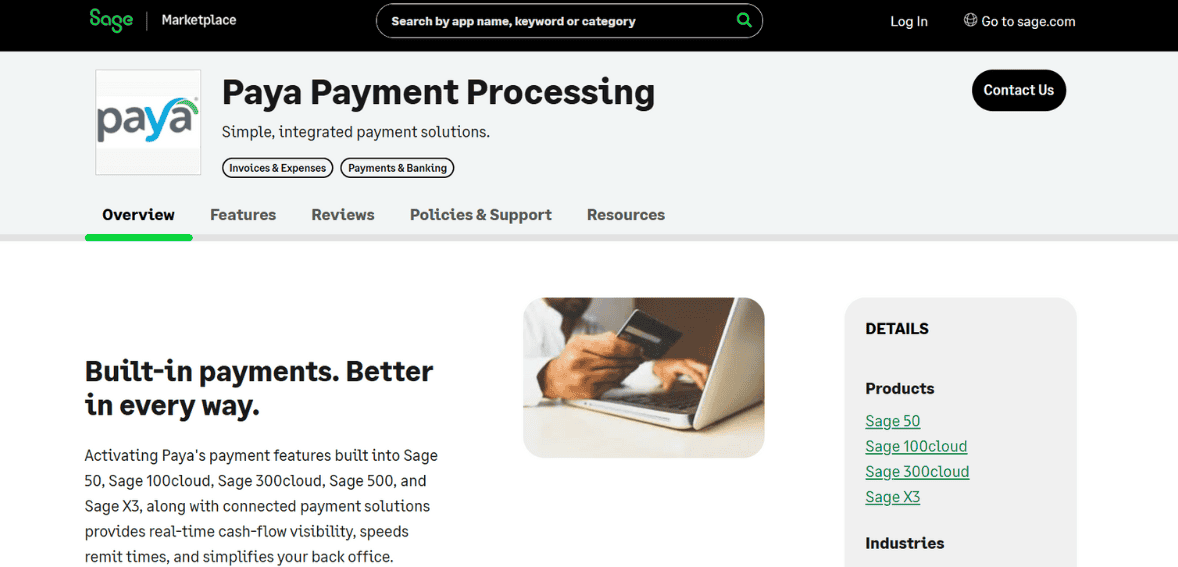Sage Payment Solutions (Paya) Review

Sage Payment Solutions began as part of The Sage Group, a global business software provider with a strong foothold in accounting and enterprise solutions. Initially tailored to serve the North American market, Sage Payment Solutions offered integrated payment processing tools to small and midsize businesses, particularly those already using Sage accounting software. The service aimed to streamline how businesses accepted and managed payments across various channels. Lets read more about Sage Payment Solutions (Paya) Review.
In 2017, a significant shift occurred when private equity firm GTCR acquired Sage Payment Solutions for $260 million. This move marked the beginning of the platform’s transformation, culminating in a complete rebrand to “Paya” in early 2018. The rebranding wasn’t just cosmetic. It aligned with a broader goal of positioning the company as a standalone payment technology provider with a sharper focus on innovation and flexibility.
Under the Paya brand, the company expanded its product lineup and emphasized modern cloud-based tools. It started targeting a broader range of industries, including education, healthcare, nonprofits, and field services. This strategic repositioning helped Paya stand apart from legacy payment processors by offering more vertical-specific solutions.
In 2023, Paya was acquired by Nuvei, a global payments technology company, further strengthening its infrastructure and product capabilities. While Paya retains operational autonomy, the acquisition is expected to open new international opportunities. Overall, the company’s journey from a software-dependent processor to a standalone, API-driven platform shows a clear evolution driven by changing market needs.
Core Services and Product Offerings | Sage Payment Solutions (Paya) Review
Paya offers payment processing for online and offline businesses. This includes credit and debit card processing, ACH transfers, eChecks and mobile payments. Businesses can process payments through countertop terminals, mobile devices, virtual terminals and integrated systems.
One of Paya’s main features is its proprietary payment gateway, Paya Connect which powers most of its payment processing. It allows merchants to process payments securely and access additional tools such as tokenization, reporting dashboards and customer data management. Paya also offers recurring billing making it a great solution for subscription based businesses and service providers. Merchants can create custom billing cycles, manage automatic payments and send digital invoices to customers.
The virtual terminal is another key feature which allows merchants to process payments through any internet connected device without needing physical hardware. This is great for service based businesses or remote billing situations. Paya’s solutions are designed to be flexible and industry-agnostic, but the company has clearly made a push to cater to niche industries. Healthcare, education, government, and nonprofit sectors benefit from specialized workflows and features that align with their regulatory and reporting needs.
Overall, Paya’s service range aims to balance simplicity for small businesses with customization for more complex organizations. It’s not the most feature-heavy platform in the market, but it offers enough tools to support a diverse range of payment needs without overwhelming the user.
Payment Gateway: Paya Connect
Paya Connect is the backbone of Paya’s payment processing technology. As a cloud-based platform, it acts as both a payment gateway and a merchant control center, giving users the ability to handle transactions, set up integrations, and manage billing within a single interface.
One of the platform’s strengths is its open API framework, which allows developers to build custom payment experiences or embed payment functionality directly into existing applications. This flexibility is particularly useful for software vendors or businesses with in-house IT teams looking to streamline payment workflows.
Security is central to Paya Connect’s design. It uses tokenization and encryption to safeguard sensitive payment information, along with built-in tools to manage fraud and maintain PCI compliance. Role-based access controls can also be configured to limit who sees what within the system, which helps businesses manage internal data access responsibly.
Paya Connect also supports advanced features such as real-time transaction monitoring, custom reporting, and customer data storage. These tools allow merchants to track trends, identify failed transactions, and manage customer profiles, all from a central dashboard. The platform is built to support both one-time and recurring payments, making it ideal for businesses that bill on different cycles. Despite its technical capabilities, Paya Connect is generally well-reviewed for its ease of use, offering a clean interface and intuitive navigation.
While it may not offer every feature found in enterprise-level platforms, Paya Connect provides a solid foundation for businesses that value both control and simplicity in their payment processing infrastructure.
eCommerce and POS Integrations
Paya supports many integrations across online and in-store. For eCommerce merchants we connect to Shopify, Magento, BigCommerce and WooCommerce. These integrations give you seamless checkout, real-time payment confirmation and automatic syncing of customer and order data.
For physical POS systems Paya supports many terminal types and POS software suites. Merchants can choose from countertop models, mobile card readers and full-featured POS systems depending on their business needs. This flexibility lets retailers and service providers design payment workflows that fit their environment.
Paya’s payment gateway is designed for omnichannel commerce so businesses can unify their payment systems across online and offline channels. This can simplify reporting, inventory management and customer tracking. For developers and software providers Paya Connect’s API allows custom integration into 3rd party applications. This is especially helpful for businesses that use industry specific platforms like practice management software in healthcare or donor platforms in non profit sectors.
Although the platform handles most standard eCommerce and POS use cases, it lacks some of the plug-and-play integration depth found in competitors like Stripe or Square. Businesses with advanced or unique integration needs may require development resources to fully utilize Paya’s capabilities. In summary, Paya provides solid integration options for standard retail and service environments, but businesses should assess their customization needs before committing.

Recurring Billing and Invoicing Features
Paya offers practical recurring billing and invoicing tools that are especially useful for businesses with subscription models or long-term service contracts. Through the Paya Connect platform, merchants can schedule automatic payments on daily, weekly, monthly, or custom cycles. This automation reduces administrative burden and minimizes missed payments.
Invoices can be generated directly within the platform and sent via email, often with embedded payment links for ease of collection. These invoices are customizable, allowing businesses to include branding, detailed service descriptions, and payment terms. The system also supports partial payments and tax configurations, which is a plus for businesses managing complex billing structures.
Merchants can monitor invoice status in real time, viewing which payments are pending, completed, or overdue. Automated reminders can be sent to customers before or after due dates, which helps improve collection rates without the need for manual follow-ups.
The recurring billing system supports both card-based and ACH payments, giving customers flexibility in how they pay. For businesses operating in regulated industries, this tool also maintains compliance by storing payment authorization securely and logging audit trails.
While Paya’s invoicing tools are functional and reliable, they are more utility-driven than design-focused. Businesses looking for sleek, customer-facing invoicing experiences may find Paya’s interface a bit plain compared to competitors that prioritize user experience. Still, for functionality and consistency, the recurring billing and invoicing features are a core strength of the platform, especially for service-based businesses.
Security, Compliance, and Risk Management
Security and compliance is non-negotiable when it comes to payment processing and Paya takes it seriously. The platform is PCI-DSS compliant and has a range of built in features to reduce fraud and protect customer data.
One of the biggest protections Paya offers is tokenization, which replaces sensitive card details with encrypted placeholders. This reduces the risk of data breaches and means merchants never have to handle raw card data. Coupled with P2PE Paya provides a secure transaction environment for online and in-person payments.
Paya Connect also has real time transaction monitoring and fraud prevention tools. These tools detect suspicious activity, flag potential chargebacks and apply transaction limits or filters. Merchants can configure risk rules by industry, region or payment type. For merchants in regulated industries like healthcare or nonprofit, Paya has audit logs and role based access controls, so administrators can assign permissions based on job responsibilities. This is especially useful for larger businesses where payment data is accessed by multiple departments.
In terms of compliance documentation, Paya provides tools to help businesses generate reports for tax, audit, or regulatory needs. These tools are especially helpful during financial reviews or external audits. Overall, Paya’s security and compliance infrastructure is robust and aligns well with industry standards. It doesn’t introduce groundbreaking security innovation, but it covers all critical bases effectively.
Usability and Merchant Experience
The user experience within Paya Connect is designed to be practical and straightforward. The dashboard offers a clean layout with clear navigation, allowing users to access key functions like transaction history, invoicing, and customer profiles without needing a steep learning curve.
Setting up a new account is generally simple. The onboarding process includes step-by-step guidance, and the initial configuration of payment methods, invoicing settings, and user roles can be completed quickly. Businesses without IT teams often find this accessibility helpful, especially if they’re transitioning from manual or legacy systems.
Once operational, merchants can track real-time payments, view transaction summaries, and pull reports directly from the dashboard. The ability to search by customer, invoice, or payment method makes day-to-day management convenient. The system also supports mobile-friendly access, although it lacks a dedicated merchant mobile app. This may be a drawback for merchants who require mobile-first interfaces or need to accept payments in the field regularly.
User reviews commonly highlight the platform’s consistency and reliability, though some note that the interface could benefit from design updates or more personalization options. Compared to some modern fintech tools, Paya Connect may feel utilitarian, but it avoids clutter and prioritizes function over flash. For businesses that prefer minimal learning curves and functional stability, Paya delivers a solid user experience without overwhelming features.
Customer Support and Service Options
Customer service plays a critical role in the payment industry, especially when dealing with issues like chargebacks, integration hiccups, or payment delays. Paya offers support through multiple channels, including phone, email, and an online ticketing system. Business hours are standard, with phone support available Monday through Friday. Emergency technical issues may receive attention faster, but merchants with after-hours needs may find the support window somewhat limiting.
Paya also provides a knowledge base with articles, how-to guides, and troubleshooting steps. While these resources are helpful, they are more functional than in-depth. Users looking for detailed API documentation or advanced configuration tips may find the support library somewhat thin. Onboarding assistance is available, and many merchants receive personalized help during setup. For businesses that require more involved integration or data migration, Paya does offer consultation and support packages.
User feedback on support is mixed. Some merchants report quick response times and helpful agents, while others have cited delays or inconsistent communication. Like many mid-size payment platforms, the support experience can vary depending on the complexity of the issue and the size of the merchant account. Overall, Paya’s customer service is reliable for day-to-day needs but could benefit from stronger documentation and broader hours of support.
Pricing Structure and Contract Terms
Pricing transparency can be a challenge in the payment processing world and Paya is no exception. They offer customized pricing based on a merchant’s volume, industry and risk profile. So upfront pricing is not always available without talking to a sales rep. Typical cost components are per transaction fee, monthly account fee, gateway fees and possibly fees for add on features like recurring billing or PCI compliance support. The structure is industry standard but it can be hard for new businesses to estimate their total monthly cost upfront.
Contracts vary, some merchants are offered month to month plans while others are tied to annual agreements. Early termination fees may apply depending on the plan chosen so be sure to read the fine print. Paya doesn’t position themselves as a low cost provider and businesses shouldn’t expect rock bottom rates. They offer value through flexibility and industry specific features. But prospective users should negotiate fees and ask about all potential charges before signing up.
In conclusion, Paya’s pricing model is serviceable but not fully transparent. Businesses that prioritize cost predictability may find better clarity with flat-rate processors, while those needing more customization might find Paya’s flexible approach worth the trade-off.

Ideal Use Cases and Limitations
Paya is best suited for small to midsize businesses that need flexible payment tools without requiring enterprise-level complexity. Industries like healthcare, field services, nonprofits, and education benefit from its features like recurring billing, ACH support, and invoicing.
Its strength lies in customizable workflows, integration capabilities, and security features that align well with regulated or service-based sectors. Businesses that already have accounting software or client management tools and need to integrate payment processing into those systems will appreciate the developer-friendly API environment.
However, there are some limitations. Businesses with high transaction volume or those looking for real-time analytics, mobile-first capabilities, or global payment expansion might find the platform’s depth limited. Additionally, the lack of upfront pricing and potential long-term contracts may be a drawback for startups or budget-conscious businesses.
Another consideration is user interface. While reliable, Paya Connect may feel outdated compared to competitors that offer more modern UI/UX or mobile-native tools. In summary, Paya is a solid choice for businesses seeking functional, secure, and moderately customizable payment solutions. It is not the most innovative platform in the market, but it balances reliability and adaptability well for organizations with niche needs.
Frequently Asked Questions
1. Is Paya (formerly Sage Payment Solutions) suitable for small businesses?
Yes, Paya is suitable for small to midsize businesses, particularly those that need recurring billing, invoicing, and ACH payments. However, pricing should be reviewed carefully.
2. What types of payment methods does Paya support?
Paya supports credit cards, debit cards, ACH transfers, eChecks, and mobile payments. It also works with online platforms and POS systems.
3. Does Paya offer strong security features?
Yes, Paya includes tokenization, encryption, PCI compliance tools, and fraud prevention features. It meets standard industry security requirements.





